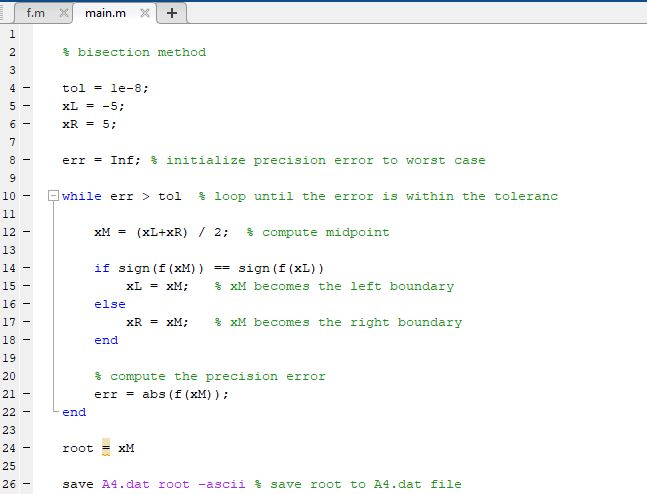Question
In: Computer Science
In matlab: Write a Bisection method with a while-loop that finds the root of the function...
In matlab:
Write a Bisection method with a while-loop that
finds the root of the function f(x) = e^(−x) −x^2 + 2 between the
values of [−5,5]. Write the function f(x) as a function file (a
separate .m file). Use the error tolerance level of “tol = 1e-8.”
Save the solved root value in the file A4.dat.
Solutions
Expert Solution




function y = f(x)
y = exp(-x) - x^2 + 2; % compute y = f(x)
end
________________________________
% bisection method
tol = 1e-8;
xL = -5;
xR = 5;
err = Inf; % initialize precision error to worst case
while err > tol % loop until the error is within the
toleranc
xM = (xL+xR) / 2; % compute midpoint
if sign(f(xM)) == sign(f(xL))
xL = xM; % xM becomes the left boundary
else
xR = xM; % xM becomes the right boundary
end
% compute the precision error
err = abs(f(xM));
end
root = xM
save A4.dat root -ascii % save root to A4.dat file
------------------------------------------------------------------------------
COMMENT DOWN FOR ANY QUERY RELATED TO THIS ANSWER,
IF YOU'RE SATISFIED, GIVE A THUMBS UP
~yc~
Related Solutions
To find a positive root for , write a MATLAB script file that uses Bisection method....
Write one a MATLAB function that implements the Bisection method, Newton’s method and Secant Method (all...
7. Finding Roots Using the Bisection Method Write a function that implements the "bisection method" for...
Using the bisection method, find the root of the following function: f(x)=cos(2x) - x Use the...
Bisection search 1. In MATLAB, implement a function that performs a bisection search. It should take...
Write Matlab programs implementing the algorithms based on bisection,Newton, and secant method for numerical solution of...
USING BISECTION METHOD, FIND THE ROOT OF 0.5e^x - 5x + 2 = 0 ON THE...
In class, we have studied the bisection method for finding a root of an equation. Another...
MatLab code for Bisection and Newton Method to find root for f(k) = p(k)^3+2*(p(k)^2)-10 on interval...
Use matlab code for bisection method and regula falsi. Thank you!
- Write a C Unix shell script called showperm that accepts two command line parameters. The first...
- You are assigned to implement the following baggage-check-in system at the airport. The system keeps track...
- Use C++ Black Jack Create a program that uses methods and allows the user to play...
- Explain how the supply curve changes as the elasticity of supply increases.
- A marketing firm is considering making up to three new hires. Given its specific needs, the...
- Construction of the new airport terminal has gone over budget and the Airport Authority needs every...
- A parent may terminate the execution of one of its children. What are the reasons?
 venereology answered 3 weeks ago
venereology answered 3 weeks ago